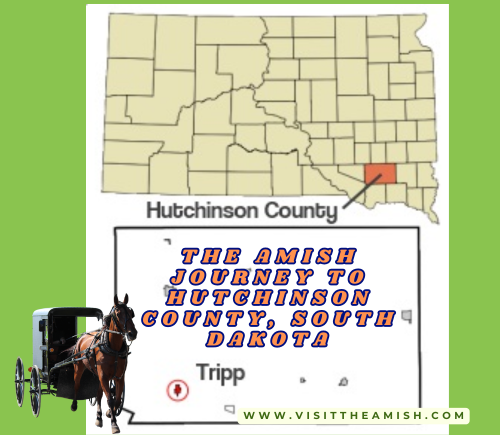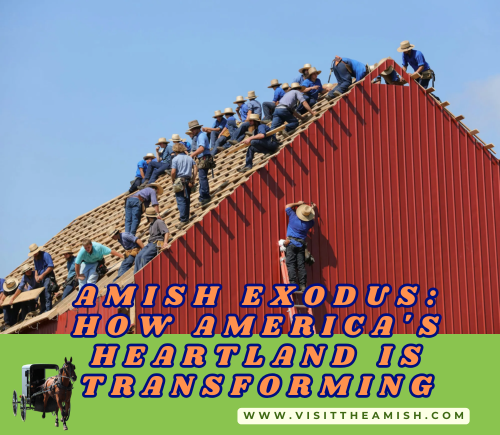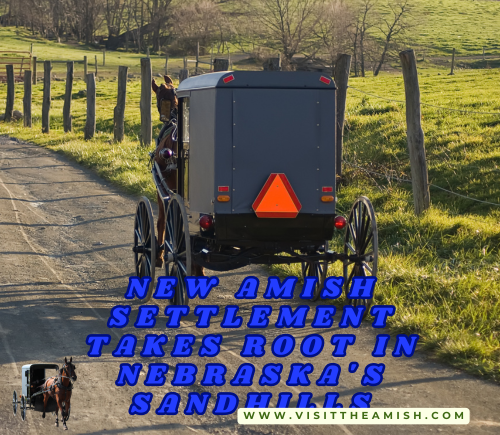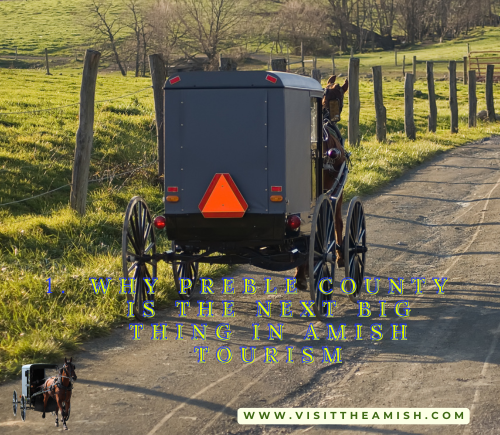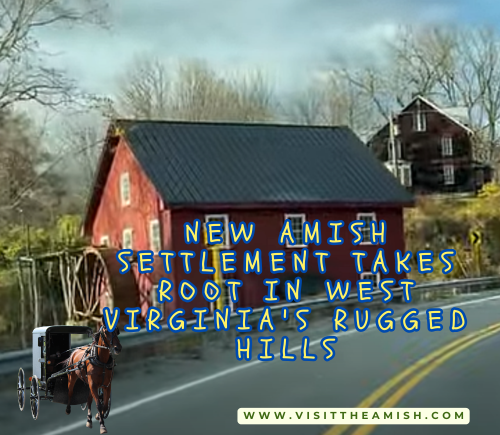From Prairie to Promise: The Amish Journey to Hutchinson County, South Dakota
In the spring of 2010, a small group of Amish families embarked on a journey that would mark a significant milestone in their community’s history. Leaving behind the familiar landscapes of Wisconsin, they set their sights on the open prairies of South Dakota, specifically Hutchinson County near the town of Tripp. This move represented not just a change in geography, but a bold step into uncharted territory for the Amish in South Dakota.
The decision to relocate was driven by a combination of factors. As Eli J. Bontreger, an Amish bishop who had previously moved to Wisconsin, once wrote about a similar relocation, “The novelty of farming these prairie lands […] wore off after a number of years, and a desire for farming on a smaller scale grew more or less on some of us”[2]. This sentiment echoed in the hearts of the Wisconsin Amish who chose to make South Dakota their new home.
The primary motivation behind the move was the search for more space and affordable farmland. Wisconsin, while beautiful and home to a significant Amish population, was becoming increasingly crowded for some community members. The wide-open spaces of South Dakota offered a chance to establish farms on a larger scale and continue their traditional agricultural practices without the constraints of more densely populated areas.

Initially, three families made the move in April 2010, settling in rural Hutchinson County[1]. The community grew quickly, with two more families arriving shortly after, and a sixth family expected by August of the same year. By then, they anticipated having about 50 people living on the farms they were purchasing[1].
The arrival of the Amish in Hutchinson County was met with curiosity and warmth from their non-Amish neighbors. Phyllis Dewald, a rural resident of the county, expressed admiration for the green thumb of one of the Amish women, Ida Borntreger, noting her skill in growing asparagus[1]. This interaction highlighted the beginning of what would become a positive relationship between the Amish and their new community.
Establishing Roots in South Dakota
As the Amish settled into their new home, they began the process of establishing their community infrastructure. One of the first priorities was to set up their own school for their children. Unlike the nearby Tripp-Delmont school district or the Hutterite schools, the Amish planned to build and operate their own educational facility, in line with their traditional practices[1].
The families quickly set about purchasing farms and building their homes and barns. Dan Borntreger, one of the Amish men, spoke proudly of the barn-building work they were undertaking, despite the challenging heat. He expressed a sense of freedom in their work ethic, saying, “We can quit any time we want, we can start any time we want. And we take Sundays off”[1]. This approach to labor reflected the Amish values of hard work, simplicity, and religious observance.
Integration and Challenges
The Amish families found ways to integrate into the local economy while maintaining their traditional lifestyle. They began shopping in Tripp, visiting the local dentist, and doing their banking in the community. They also purchased livestock at the local sale barn and continued their practice of butchering their own meat[1].
However, the transition was not without its challenges. The open landscape of South Dakota, while offering the space they sought, was quite different from the more wooded areas they were accustomed to in Wisconsin. Rudy Borntreger, who would later become the community’s bishop, noted, “We wanted there to be an Amish community here, but seems like everybody Amish is more from Ohio or Pennsylvania, where there are more trees”[4]. This geographical difference would later prove to be a factor in the community’s struggle to attract new families.
Growth and Community Relations
Despite the challenges, the Amish community in Hutchinson County continued to grow. By 2014, the settlement had expanded to nine families[7]. The bishop at the time reported that the group was “pretty well welcomed to the community,” with only minor issues such as some locals expressing concern about horse droppings on the roads[7].
The Amish’s presence in the area left a lasting impression on their neighbors. Marion Ymker, the owner of Ymker Greenhouse and Landscaping in Armour, where some of the Amish had worked for about a decade, expressed disappointment when learning of their eventual decision to move, saying, “We love ’em here”[4].

Economic Pursuits and Adaptations
Initially, many of the Amish families in Hutchinson County pursued dairy farming, continuing a tradition they had brought with them from Wisconsin. However, they faced several challenges in this endeavor. The difficulties in maintaining dairy operations in South Dakota led to a shift in their agricultural focus.
Adapting to the local conditions and market demands, the Amish community transitioned to raising bottle calves imported from out of state. This became the main occupation among the settlers, demonstrating their ability to adjust their economic activities to the realities of their new environment[4].
The Amish also engaged in other trades and services, as is common in many of their communities. Some found work in nearby towns, such as at the greenhouse in Armour, contributing to the local economy while maintaining their distinct lifestyle.
Challenges and Decisions
As the years passed, the Hutchinson County Amish settlement faced ongoing challenges. The difficulty in attracting new Amish families to join them in South Dakota became increasingly apparent. The open, treeless landscape that had initially offered the space they sought now seemed to be a deterrent for potential newcomers more accustomed to the wooded areas of Ohio, Pennsylvania, or Wisconsin.
Water scarcity was another significant issue. The area where they had settled had limited groundwater resources, forcing the community to rely on the rural water line. This necessity created an interesting juxtaposition with their traditional avoidance of modern utilities, as noted by a local observer: “Apparently their inhibitions to electricity as being unequally yoked with nonbelievers does not extend to the water pipe that they are also connected to non Amish with”[7].
Economic challenges also played a role in the community’s struggles. South Dakota’s economy, which had seen a significant exodus of “English” (non-Amish) residents, proved to be a difficult environment for the Amish to thrive in as well.
The Decision to Relocate
By the early 2020s, after more than a decade in South Dakota, the Amish community in Hutchinson County made the difficult decision to relocate. Rudy Borntreger, who had become the community’s bishop, explained the reasoning behind this move: “Now more people decided to move back to Iowa and Minnesota, so kind of for unity’s sake”[4].
The decision to leave was not taken lightly. Borntreger, who had spent around half of his adult life in South Dakota, expressed a bittersweet sentiment about their time there: “Good country. Good area. Good friends,” he said, noting the changes that had occurred over their 13-year stay, including the passing of old friends and changes in local businesses[4].
Legacy and Future Prospects
As the Amish prepared to leave Hutchinson County, they left behind a legacy of hard work, community spirit, and cultural exchange. The vacant farms they had built up from nothing stood as testament to their efforts and as potential opportunities for others who might wish to live in the area.
Interestingly, while the Hutchinson County settlement was coming to an end, there were indications of Amish establishing themselves in another part of South Dakota, specifically in the area of Burke in Gregory County[4]. This development suggested that while one chapter was closing, another might be opening for the Amish in South Dakota.

Reflections on the Amish Experience in South Dakota
The story of the Amish in Hutchinson County, South Dakota, offers valuable insights into the challenges and adaptations faced by traditional communities in new environments. Their experience highlights the delicate balance between maintaining cultural and religious traditions and adapting to new geographic and economic realities.
The warm welcome they received from their neighbors and the lasting impressions they left demonstrate the potential for positive cultural exchange and community building. At the same time, their struggles with attracting new families and adapting to the landscape underscore the importance of familiar environments in sustaining close-knit communities.
As the Amish of Hutchinson County prepare to write the next chapter of their story in other states, their brief but impactful presence in South Dakota serves as a reminder of the ongoing evolution of America’s cultural and religious landscape. It also highlights the resilience and adaptability of the Amish people, who continue to seek out ways to preserve their traditional way of life in a rapidly changing world.
The journey of these families from Wisconsin to South Dakota and back again is more than just a tale of migration. It’s a story of hope, perseverance, and the enduring strength of community bonds. As they move on to new horizons, the lessons learned and the friendships forged in the prairies of South Dakota will undoubtedly inform their future endeavors and remain a unique chapter in the rich history of Amish settlements in America.
Tags: Amish, South Dakota, Hutchinson County, Wisconsin, migration, farming, community, rural life, cultural adaptation, traditional lifestyle, agriculture, bottle calves, education, religious freedom, economic challenges, water scarcity, community relations, cultural exchange, resilience, Amish settlements
Citations:
[1] https://peacefulsocieties.uncg.edu/2010/07/22/warm-welcome-for-amish-migrants-into-south-dakota/
[2] https://mki.wisc.edu/exhibits/npp/panel-06/
[3] https://visittheamish.com/the-amish-in-south-dakota-a-brief-history-includes-video/
[4] https://amishamerica.com/amish-leaving-south-dakota/
[5] https://www.youtube.com/watch?v=9FMvGTeBorg
[6] https://www.hmdb.org/m.asp?m=182291
[7] https://amishamerica.com/amish-hutchinson-county-south-dakota/
[8] https://www.jstor.org/stable/2562217

